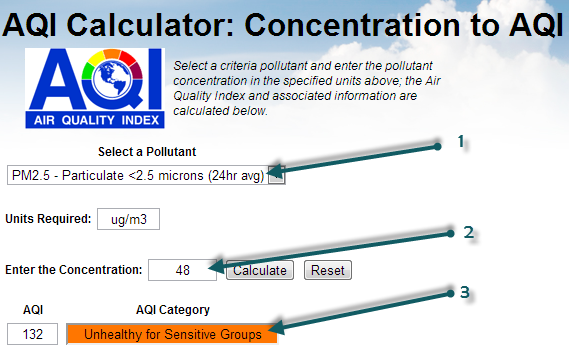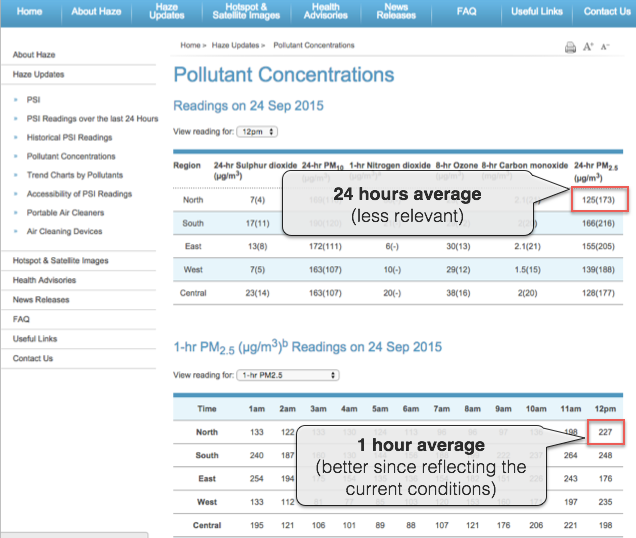In April 2014, the Singapore NEA has updated the PSI calculation to also include PM2.5. http://www.nea.gov.sg/anti-pollution-radiation-protection/air-pollution-control/psi
เนื่องจาก หมอกควันในเอเชียตะวันออกเฉียงใต้ล่าสุดจากอินโดนีเซีย ส่งผลกระทบต่อสิงคโปร์และ มาเลเซีย ในปัจจุบัน เรามีคำถามมากมายว่าทำไมจึงมีความแตกต่างระหว่างข้อมูลที่อ่านได้จากเว็บไซต์ NEA ของสิงคโปร์ ( nea.gov.sg ) และโครงการดัชนีคุณภาพอากาศโลก ในสิงคโปร์ หน้าเว็บ .
ตัวอย่างเช่น นี่คือสิ่งที่สามารถอ่านได้ในวันนี้ในเว็บไซต์ NEA:

ด้วยเหตุผลทางประวัติศาสตร์บางประการ สิงคโปร์จึงใช้ PSI ( ดัชนีมาตรฐานมลพิษ ) เพื่อประเมินคุณภาพอากาศ ในภาพด้านบน หมายเลข 1 ตรงกับค่า PM10 ที่ใช้ในการประเมิน PSI ค่า 67(/59) สามารถอ่านได้เป็น 67 μg/m3 ซึ่งสอดคล้องกับ PSI ที่ 59 PSI ได้รับการประเมินว่าเป็นค่าสูงสุดของ PSI แต่ละตัวสำหรับมลพิษแต่ละรายการ: PM 10 , SO 2 , NO 2 , O 3 (โอโซน) และ CO 2 .
PSI(Singapore-North) = max( PSIPM10-based, ... PSIO3-based )= max (59, ..., 77) = 77
ที่กล่าวว่าสิ่งที่น่าสนใจคือในตารางเดียวกันนี้ข้อมูล PM2.5 ระบุไว้ในคอลัมน์สุดท้ายด้วย (ดู 3) ข้อมูลนี้มีให้ในหน่วย μg/m3 เท่านั้น (ดู 2) และไม่มีการแปลงเป็น PSI (เช่น การแปลงจากมวล PM2.5 ไปเป็นมลพิษหรือดัชนีคุณภาพ) อย่างไรก็ตาม การแปลงนี้มีอยู่ และถูกกำหนดโดย หน่วยงานคุ้มครองสิ่งแวดล้อมของสหรัฐอเมริกา วิธีที่ง่ายที่สุดในการแปลงคือการใช้เครื่องคิดเลขออนไลน์ ซึ่งมีอยู่ที่ airnow.gov :

If you select the PM2.5 (1), then enter the mass concentration of 48 (2), can click on Calculate, you will obtain the AQI of 132 (3). So, based on the PM2.5 AQI conversion, the PSI that is used for Singapore could be extended (let's call it PSI++) to also take into account the PM2.5 information. In which case, the PSI++ would be the maximum of the regular PSI (based on PM10 only) and the PM2.5 AQI:
PSI++ = max( PSI, AQIPM.25 ) = max( 77, 132 ) = 132
This PSI++, that is commonly referred as AQI (or Air Quality Index), is what is being used on the the World Air Quality Index project, for all the cities (provided PM2.5 is available for the city). And this explains why the values are different between the NEA website and the World Air Quality Index project.
Moreover, when doing the convertion, make sure you use the 1-hour reading for the PM2.5 concentration rather than the 24-hours averaged value, as shown on the below image:

http://www.haze.gov.sg/haze-updates/pollutant-concentrations/type/PM25-1Hr
If you want to know more about PM10 vs PM2.5, and especially why PM10 is still used, please check the faq entry about why is PM2.5 often higher than PM10? Is PM10 still a relevant measure?
--
For more information about specific countries or continent, please refer to those articles: Thailand and Malysia - India - China - Hong Kong / Canada (Air Quality Health Index) - South America - Australia - Quebec and Montreal - Singapore - Poland - Indonesia .
For information about the 24 hours averaging used or Ozone and Particulate Matter (PM2.5), please refer to those two articles: Ground Ozone Index - PM2.5 Instant Cast
